How to pull a tick from a person - the basic rules of this procedure are worth knowing. But they can be used only as a last resort, when there is no way to contact the surgeon. The fact is that it is easy to remove the mite by half, the second half often remains in the skin. In addition, only whole mites are taken to the laboratory for research.
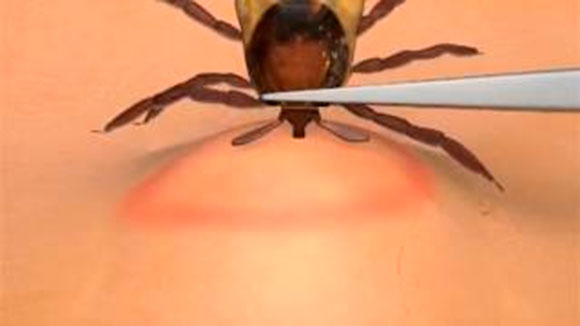
Than the mites are dangerous
As is known, it is the mites that carry vectors of such serious infections as tick-borne encephalitis, crimean hemorrhagic fever 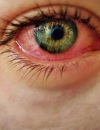 and so on. Therefore, in places where sporadically there are cases of such diseases, you need to be especially careful with ticks. Best of all, while walking through the forest wear high boots (ticks are most often found in grass and shrubs), tight trousers and a jacket. In addition, you can use special aerosols from ticks. Unfortunately, ticks are found not only in the forest. They can lie in wait for a man in the grass near the house, as well as in any other place.
and so on. Therefore, in places where sporadically there are cases of such diseases, you need to be especially careful with ticks. Best of all, while walking through the forest wear high boots (ticks are most often found in grass and shrubs), tight trousers and a jacket. In addition, you can use special aerosols from ticks. Unfortunately, ticks are found not only in the forest. They can lie in wait for a man in the grass near the house, as well as in any other place.

How to remove a tick from a person - the basic rules
The mites, getting on a skin, not at once bite into it, they can long enough search for the most attractive place for itself. Usually this place is where the thin skin is on the neck, abdomen, between the fingers and so on. Therefore, if a person has found a tick on the body, it is first to calmly check whether it is attached to the surface of the skin. If not, then just brush the tick (and even more pressure on the surface of the skin) is not worth it, it is better to shake it on some object, and then burn it.
If the mite is squashed on the surface of the skin, even if it has not yet penetrated it, infection through unnoticeable micro-trauma on the skin can occur. If the tick still digs into the skin, extract it better in a medical facility. The advantage of such extraction will be: extraction of the whole mite completely, quality wound treatment, transfer of the extracted insect to research and monitoring the condition of the victim for a certain time (incubation period of tick-borne infections in the area).
If the mite is removed roughly and incorrectly, then the head may come off. It remains in the skin and can cause a local inflammatory process.
If the tick is the carrier of an infectious factor, then if its integrity is compromised, the pathogens of infection also enter the wound.

How to remove a tick from a person in a medical facility
The most effective is the way in which the mite is blocked by the access of air, it has nothing to breathe and it begins to get out. To this end, in a doctor's office, a cotton fleece is applied to the mite for 10 minutes, soaked with 70% alcohol, after which the tick is removed with tweezers, placed in a sterile screw-caped tube and sent to a laboratory. After testing, the mite is burned in a microwave oven.
After the tick is removed after the removal of the tick for the next two weeks, the doctor observes, he must measure the temperature twice a day, monitor his health and immediately consult a doctor in case of illness.

How to pull a tick from a person yourself
It is not advisable to remove the tick itself, but sometimes circumstances develop so that there is simply no one to do it. There are several ways to remove ticks. First of all, you need to remember that the tick is screwed into the skin in a clockwise direction, so it should be removed in the opposite direction, that is, counter-clockwise.
To remove, the airlock must be blocked. If you do not have alcohol at hand, you can replace it with a drop of vegetable oil or cotton wool, moistened with water and soaked with soap. Just like when applying alcohol, after about 10 minutes the mite is selected outside. It should not be taken by hand. Better forceps or any improvised material, for example, a napkin. If there is no possibility to send the tick to the laboratory, the napkin together with the mite should be burned. The wound should be treated with any antiseptic - 5% alcohol solution of iodine, zelenok, alcohol and so on.
If, despite the fact that the mite was blocked by air, it did not completely come out of the skin, you can try to unscrew it counter-clockwise, using also tweezers or a napkin. But this is dangerous, since the head can come off and stay in the skin. In this case, you still have to seek medical help.
Removing the tick with a thread is inappropriate and dangerous, as in most cases it leads to damage to the insect and the possible introduction of the infection.
In the pharmacy you can buy a special hook (twist) for removing ticks. In order to remove the tick, it is necessary to hook it with a hook and make several rotational movements counter-clockwise. The tick will remain on the device to pull the ticks off unharmed. The ticks removal tool excludes the poisonous saliva of the bloodsucker from entering the wound, as it does not shrink when seized. The device for extracting ticks takes it whole, together with the proboscis.
Galina Romanenko
Ticks come in different types of their more than 50 thousand and all can not remember. But a person should know how to visually distinguish a tick. Ticks belong to a class of arachnids and therefore, externally has a similarity to a spider. The only thing, ticks very small in sizes and to see them at once it is practically impossible. In addition, their color often coincides with the colors of surrounding objects.
In a person afflicted with this type of disease at the initial stage, dizziness, severe pain in the region of the temples, there is constant nausea and fever. If the time does not go to the hospital with time comes paralysis and in some cases death.
The next dangerous disease that occurs due to a tick bite is Lyme disease. During infection, the nervous, circulatory and support - motor systems are affected. In some cases with Borreliosis disease, and heart.
All these and other diseases are difficult to determine immediately after the bite, as their development process can last for several days.
Attack and bite
Therefore, as soon as a tick bites a person you need first of all to pay attention to the place of bite. If the stain has increased in a few hours, then immediately it is worth consulting a doctor for diagnosis. Within 1.5 to 2 weeks after the bite, the disease shows itself with the symptoms. Without taking any measures, a person exposes himself to the danger of getting sick.
Ticks bite a man's skin, so, hitting on clothes, they quickly look for a loophole to the naked body. When the tick crawls along the body, it is easy to feel it as its movements are careless. Once the mite has chosen the right spot, it immediately makes a bite.
Most often ticks suck in the groin, abdomen, chest, armpits, neck, ears and lower back. The sensation is like a mosquito bite and so it can be overlooked. Immediately after the bite, the mite begins to make its way deep into the skin. Here, then, a person begins to feel discomfort in the affected area: the overburden, heat, enlarged lymph nodes and chills.
How to pull out
How correctly to pull out the tick? Just pull it out in no case it is impossible!
As soon as a person finds a sucking mite on himself, he must be removed immediately. The easiest way to remove a tick is thread.
It is necessary to cut off the most common thread and tie it with the torso of the mite, while the thread is not tightened so as not to cut its body. Then, taking hold of the ends of the thread, start twisting it by the hour hand. You need to do this slowly, so that the tick completely comes out.
- How to pull a tick from a person with oil and a lid?
Take any lid from under the plastic bottle and make in it a hole in the middle. On the outside, attach the lid to the bite so that the mite is inside it. Then gradually pour in the sunflower oil. Ticks need air, and when oil overcomes it, it will start to creep out.
Still it is possible to pull out a tick at the person in house conditions with the help of a candle. To do this, you need to light a candle and drip wax on the mite.
- How can I remove the head of a tick?
It is necessary to take the tick very carefully, but if it did turn out that its head remained in the skin. In this case, this place must be wiped off with alcohol, and the head of the tick is removed with a sterile needle, as an ordinary splinter.
What to do next
Once, the tick was removed from the body, it must be passed to the laboratory for infection testing. All medicines are attributed only by the doctor according to the results of the analysis. Doing self-medication after an infected tick bite can be detrimental to health.
After the tick has gotten the place of the bite, it's best to pour iodine, and wash your hands thoroughly with soap or disinfectant.
Behind the site of the tick bite, you must constantly monitor it as if it is infected, then changes will be visible. Therefore, as soon as a person has noticed an increase in the red spot, he has seen a rash all over his body, and his temperature has risen, he should immediately consult a doctor.
Remember the danger of catching tick-borne encephalitis!
Preventive measures and precautions
Therefore, to protect yourself from the tick bite, and so you do not have to pull it out, you need to take small precautions.
- Before deciding to go into the woods, you need to pick up light clothes with tight cuffs;
- It is advisable to tuck your pants into socks or boots;
- On the head put on a cap or kerchief;
- It is also useful to take a litter of white color, it is always visible to all insects in the same case and mites.
To scare off a tick, some people resort to repellent means. They can be sprayed on clothes as well as on the body. Such preparations include, for example, "Off", "Pikhtal", "Permanon", "Medelisik for children", etc.
Aquaricides not only scare the tick off their clothes, but also paralyze them. But with this tool you need to be very careful, because of its toxicological indicators, it can not be applied to clothing.
Such aerosols include "antiklesch - Tornado", "anti-cellulite-gardex", "anti-cellulose-picnic". Apply aerosol to the places of cuffs and belts, jute until it dries and only then clothes are put on.
It is important to remember that any of the funds must be purchased only at specialized points of sale, otherwise they can harm human health.
Every fifth tick is dangerous to human health, so you should be very careful, going to the places of rest, especially if it's very hot.
Supplement: symptoms of encephalitis
Encephalitis is a very serious disease associated with inflammation of the brain.
Causes of the disease
The cause may be both a viral infection and insect bites.
In the second case, it is the bites of such insects as a tick or mosquito. In addition, this kind of encephalitis can be infected and through raw milk, which was infected.
There is encephalitis caused.
Do not forget that this disease can be transmitted through the air from a person who has contracted an insect bite.
Symptoms of the disease
Typically, the symptoms depend on the causes of the disease. However, there is a common symptom for this disease. This is a headache. It can be different - sharp, dull, shooting, aching. Such pain is always present in the presence of this disease. In addition, there may be nausea, weakness and malaise.
Of course, on these grounds, you can confuse this disease with ARVI. So, as a rule, there is an asymptomatic encephalitis. Therefore, it is very important to consult a doctor. But there are others that relate to the severe form of this disease. It can be convulsions, jerks, of course, involuntary.
There may be tinnitus or hearing loss. Also, the diseased can lose consciousness. Occurrence of hallucinations,
paralysis, fear of light and noise. Astereregnosis can occur when a person ceases to recognize objects. In addition, a sharp rise, up to 40 degrees, temperature, sore throat, cough.
As soon as such symptoms have arisen, it is urgent to call a doctor at the house. Since this disease can develop very quickly and end with death.
In young children or babies this disease manifests itself in the following way: nausea, vomiting, incontinent crying, even if it is picked up, spasms, bloating, and refusal to eat.
As a rule, small children, or, conversely, the elderly, are at greatest risk of infection. Those who are weakened by immunity are not vaccinated against measles, rubella and mumps. And, of course, travelers to such places that are especially prone to encephalitis infection.
How to detect a tick?
Ticks are considered to be rather inactive beings. In fact, from the tree they dive quite seldom - this is more likely an accident than constancy. Bloodsuckers prefer to take a wait-and-see attitude, hiding in the leaves of small bushes or trees, or in the grass.
Studies have confirmed that the tick feels the approach of a dog or a person about ten meters. As the victim approaches, the insect picks up its front paws with claws and skillfully clings to wool, hairs, clothing or just skin.
After the bloodsucker clings to the body, he continues to search for the most delicious area for some time. This process takes about an hour, and you may well have time to eliminate it before it pierces your proboscis with your skin.
Than to pull out the tick or mite?
There are several devices that significantly facilitate the complex procedure for pulling the mite. Some of them can be purchased at the pharmacy, while others can be easily manufactured independently from improvised means.
Clamp / tweezers
The most convenient and suitable device that effectively removes ticks is a special surgical clamp that can be replaced with curved tweezers. This design allows you to gently pick up the mite under the proboscis itself, after which it is scrolled and slowly pulled upwards to completely remove from the skin.
Only a couple of turns will be enough to eliminate the bloodsucker. However, remember that sharp movements are fraught with rupture of the tick - the insect can leave its proboscis in the skin, which is fraught with various complications. In addition, you can not heavily press on the belly of a bloodsucker, because it can crumble and all its contents will fall into the wound, infecting a person.
Special constructions
To eliminate the tick you can use specially designed designs that you can buy at the pharmacy. Such devices somewhat resemble a two-pronged plug having a curved end. They need to pick up the mite and carefully unscrew it. These devices do not squeeze the abdomen of the insect, which reduces the probability of infection of an order by an order of magnitude.
Thread
To eliminate bloodsuckers in the field, you can use the most common thread. Take a strong thread and wrap it with a loop at the very base of the mite - close to the skin. Tie a knot and in a circular motion gently rotate the mite and pull it up. A sharp movement is fraught with inflammatory reactions and infection. That is why the removal of the tick must be neat, during this process care and concentration are needed.
After you pull the mite, you need to disinfect the area of skin where it was. To do this, you can use hydrogen peroxide, zelenoku or iodine. In the event that the tip of the proboscis is still inside the wound, it is important to ask for a doctor's help without fail. The extracted mite should be put in a glass jar and carried to the SES for research.
After a bite, you need to closely monitor your condition for increased temperature and other symptoms of infection. With redness of the bitten place, headache, vomiting, fever, painful sensations and other alarming manifestations, you need to contact the doctor. Only an infectious disease doctor can accurately determine whether you need his help.
Danger
Ticks can infect a person with a variety of ailments, including Lyme disease and tick-borne encephalitis. These conditions carry a serious threat to health, and sometimes life. However, even if the insect that bites you, was a carrier of the disease, you do not necessarily get sick. Timely analysis of the tick and certain preventive measures will prevent infection.
Sunshine came. Many people rush to relax on the nature with children, pets. But to spoil the event can be a sucked dangerous tick. How to remove a tick from a person correctly?
There is a common opinion - it is best to burn out a match, strangulate with petroleum jelly, poison with nail polish or kerosene.
Never use these methods! This only deeper pushes the mite and it will allocate more saliva, which will increase the likelihood of transmission of the disease.
Using tweezers

If you find an infected mite in an adult, or a child, use tweezers.
- Determine where the head of the tick is. Look closely and see!
- Using forceps, grasp the head as close as possible to the skin. The tweezers are best used with a sharp thin tip for a secure grip. Do not try to make it with your fingers.
- Make sure that the head is seized. Do not lift the body of the tick. This will lead to the fact that he will release his saliva into the blood and the chances of transmission of the disease will increase.
- Pull the mite slowly but surely. Do not twist, do not jerk or twist the tweezers. Otherwise, it will come off halfway. If, however, some part remains in the body, try to achieve its removal.
- Place the mite in a jar or paper envelope in case you later want to determine whether it is infectious.
- Wash your hands and bite area with soap.
- Tampon the place of bite with alcohol, hydrogen peroxide, iodine or
If the child is bitten (and the adult too!), Contact for an assessment of his condition to the doctor. At a high risk of infection, antibiotics can be prescribed. Call a doctor if the child has:
- red rash rimmed or the skin became red and irritated;
- symptoms similar to influenza;
- joint pain;
- swollen joint;
- paralysis of the facial nerve.
Using a thread
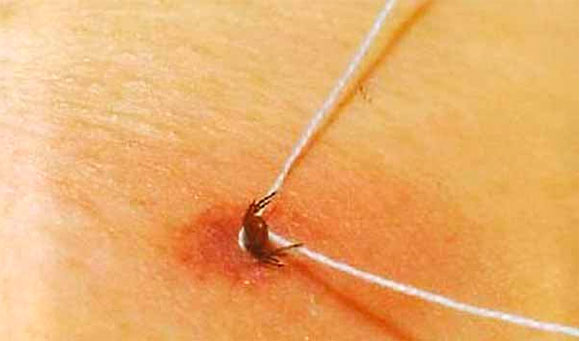
If you did not have a pair of tweezers, you can use the thread.
- Choose a thin, strong, not long thread.
- Wrap a thread loop around the head of the mite, as close as possible to the skin.
- Tighten the loop around the head.
- Pull the ends of the thread upward with slow but sure movements. The tick releases the skin.
- For the disinfection of the hands and the place of bite, use the same means as described above.
- Check the wound constantly for signs of infection with tick-borne disease. Circle the bite around. And during the day, several times control whether the redness extends beyond its borders.
Call your doctor right away if you notice the following symptoms:
- Fever or chills. This is a common symptom of tick-borne diseases.
- Headaches and pains in the muscles.
- Rash in the eye area. This is a symptom of Lyme disease.
- Any other rash
Using a syringe
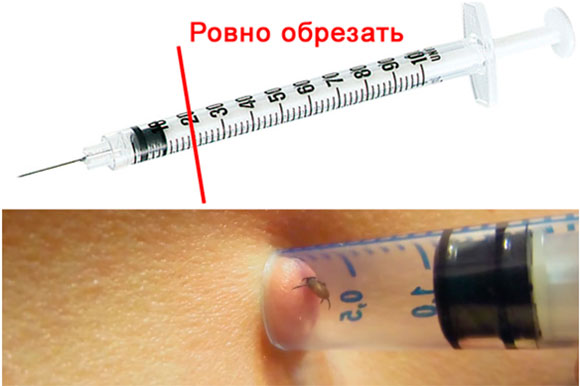
Take a regular new syringe by buying it in the pharmacy. Carefully, but as much as possible cut it slightly above the place where the needle is attached. Cut off the cut edge with water or saliva, for better adhesion to the skin.
Special tools
You can simplify the task of removing the tick using special devices designed for these purposes. They are sold in the pharmacy and can easily poddet insect closer to the proboscis, quickly and painlessly pull out entirely. For example, nipper, clinver (Nipper, Klinver), etc.
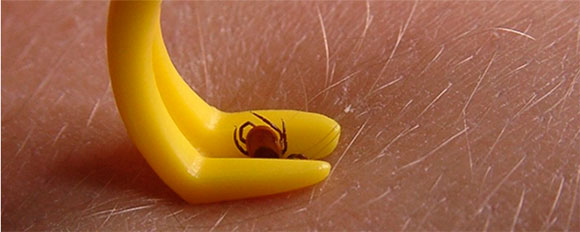
other methods
Oils
Someone manages to extract an insect with the help of a drop of ethereal or mint. But this does not always work.
Nail scissors
You can use a manicure scissors, if there are no other tools and tools. Spread them a little, fix with your fingers. Pull the mite, grabbing it under the bottom, closer to the skin and pull it out.
Advice of experienced
What to do next
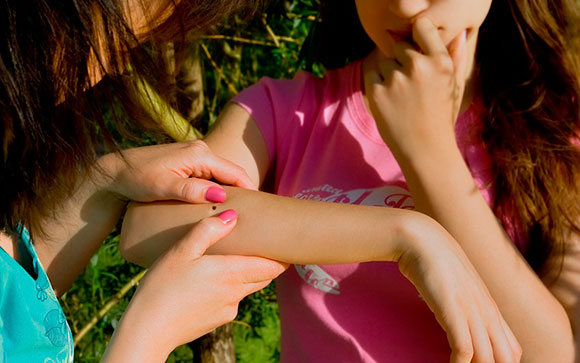
Keep calm
Tick infections, as a rule, affect the nervous system. Take 20 drops of valerian or other soothing
Make a paste
Take in equal parts of green clay and plantain leaf powder (pinch). If there is no powder, you can do without it. Add a few drops (until the mixture turns into a paste) andrographis tincture - it quickly removes toxins from the body.
Place the paste on top of the bite. You can cover with polyethylene and attach a heating pad to enhance the effect. When the paste dries, rinse the area with cold water. Apply 4 times a day.
Astragalus tincture
It is recommended to take a large dose of astragalus tincture - 3000 mg per day for the first month after the bite, and then to 1000 mg for prevention (approximately 46 drops three times a day). All this will be required to avoid emergency physician help.
Check for mites
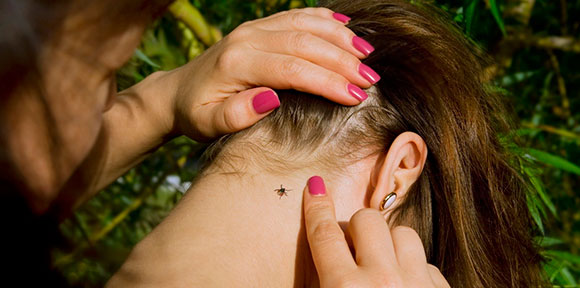
Have you ever removed a tick? How did you cope with this? Share, please, in the comments?
Posted on July 26, 2011 - 20:07
How to remove the tick safely
Ticks wake up in the spring, the code temperature rises, the snow melts, the air becomes wet. The greatest activity of ticks occurs in March-May and August-October, in summer the activity becomes less.
If you find a tick, you can remove it yourself. For this, it is convenient to use curved tweezers.
Grab the tick as close as possible to the proboscis, start sipping and rotating it around its axis. You can not jerk sharply, you can break it in half. After 2-3 turns you will extract the tick along with the proboscis without tearing it in half.
If you do not have tweezers, then make a loop of strong thread, grab the mite and gently pull it, while you have to sway it in different directions. Put a loop on the mite closer to the skin.
If there are no tweezers or threads, wrap your fingers with a clean bandage and grab the mite as close to the skin as possible and gently pull out the rotational movements.
Once removed, treat the wound with iodine, or alcohol. Handle gently, do not burn skin. Be sure to clean hands and tweezers after removing the mite. Remove the removed tick, place in a wet bandage, cotton wool, place in a jar and take it for analysis. You can store the tick for no more than 2 days. You can not take mites with bare hands, put on gloves, or use tweezers.
Do not be frightened if the head with the proboscis comes off and remains in the skin. Treat the wound with iodine, after a while an abscess is formed, and the proboscis itself will come out. If the proboscis is visible above the skin, grab it and unscrew it. If everything is ok, the wound will heal in a week.
Remember:
You can not jerk the tick when you pull it out.
Do not squeeze it with your fingers.
Do not lubricate the mite with oil, gasoline and other caustic substances, do not burn with a cigarette. This you do not destroy it, it will only begin to suck more deeply and release the poison.
The bite site can not be picked with a needle or a pin and cut.
Olga-Alyonushka
Posted on July 27, 2011 at 2:23 am
Ticks and protection from them
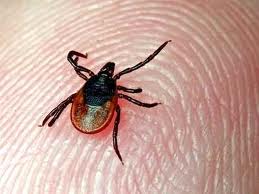
With the bites of ticks, thousands of people collide. Some of them develop tick-borne encephalitis and / or borreliosis. Ticks become active in warm weather. Usually, in April, the first victims of their bites are turned to doctors. The Sanitary Service warns that from insects you can get very dangerous diseases. At the same time, the knowledge of the population about mites and diseases transmitted by them is extremely small.
Biology of ticks
Their victims are waiting for the mites sitting on the ground or grass, exposing the front paws, which are special sensory organs that react to heat and smell. When a potential victim passes by a tick, it clings into its front paws. Mites do not jump and do not fly. In order for the tick to hit the body, it is necessary to pass in close proximity to it.
Once on the body, the mite bites not immediately. Before sucking the tick can take several hours. If the tick is seen on time, then the bite can be avoided.
After selecting the place of the bite, the mite bites the skin with chelicers and inserts into the wound with a hypostome (special throat outgrowth similar to a harpoon). Hypostom is covered with chitinous denticles, which hold the tick. Therefore, it is difficult to remove the mite.
The bite is well anesthetized by the tick, so the tick bite is invisible. With the saliva, the tick infects various substances that prevent blood clotting, which increase blood flow. On the body of the tick can be several days. Especially a lot of blood is drunk by adult females. More than 100 times their weight. Therefore, the female is on the victim longer than the male (a week or more). After the mite has drunk blood, he pulls the proboscis out of the body and falls off.
Mite bite: what to do?
Noticing the bite of a tick, people behave differently. Someone removes the tick and forgets about the bite. Someone is hysterical with someone. Both of these approaches are incorrect.
On the one hand, the tick bite represents a certain risk of various infections, so you need to consult a doctor and, if necessary, get a prophylaxis. But you do not have to get hung up on a bite, thousands of people bite in a bite for a season. At the same time, it falls ill by several orders of magnitude less. The tick bite does not at all mean that a person will develop tick-borne encephalitis and / or borreliosis. Even if a tick is found to be the causative agent of any infection, this does not mean that the disease will develop. And tick-borne encephalitis does not always end with death or disability.
Noticing the bite, you can remove the mite yourself or go to the emergency room, polyclinic or the point of prevention of tick infections.
For specialized prevention of tick-borne encephalitis, you need to contact a special point. After removing the mite and examining the doctor, in the absence of contraindications, adults are given iodantipyrine, which is given for free. Seroprofilaktika immunoglobulin is administered only to children free of charge, since iodantipyrine can only be used after 14 years. Adults it is introduced for money, the cost of the drug, depending on the body weight. At the same time, immunoglobulin differs little from iodantipyrine in effectiveness. And in some cases, the introduction of immoglobulin is not only useless, but also dangerous. Therefore, one should not buy immunoglobulin independently, it is not a panacea for tick-borne encephalitis.
Some antiviral actions against tick-borne encephalitis virus have also been remantadine (often used for the prevention of influenza). For the prevention of tick-borne encephalitis, remantadine is prescribed (no later than 2 days after the bite) in 100 mg 2 times / day with a 12-hour interval for 3 days.
For prophylaxis it is necessary to address in the first 4 days after a tick bite (iodantipyrine). Prophylaxis with immunoglobulin is carried out in the first 3 days. At a bite time of more than 4 days, prophylaxis is not carried out by either immunoglobulin or iodantipirin.
Both iodantipyrine and immunoglobulin are preparations for the prevention of tick-borne encephalitis. They do not protect against tick-borne borreliosis and other infections. For the prevention of borreliosis, a course of antibiotics can be prescribed.
Tick can be investigated for money for the presence of tick-borne encephalitis virus and Borrelia. There is no strict need for such an investigation. Examination of the tick is desirable, but not necessary. Prevention of encephalitis is carried out regardless of the results of the study of the tick. The presence of an agent in a tick does not at all mean that the bitten will develop encephalitis or borreliosis. A negative result does not always ensure that the disease does not develop (the mite is poorly preserved, the sensitivity threshold of the test system, there were other bites). If found in a tick borrelia, you can prescribe a course of antibiotics (if not prescribed earlier) for the prevention of borreliosis.
At the time of the tick bite, redness and swelling in the bite site can develop. It's a reaction to a bite. Borreliosis erythema (redness), appears a few days after the bite (usually not earlier than a week). The reaction to the bite is a few days after the tick is removed. If you take antiallergic drugs (suprastin, tavegil, claritin, erius), then the reaction to the bite disappears more quickly.
Immediately after the bite, blood tests should not be taken, in case of infection, the test results no earlier than 10 days later.
Removal of mite
Victims of tick bites are often asked whether it is possible to remove the mite on their own. Can. There are several ways to remove ticks. But all of them differ only in the instrument by which the tick is removed.
It is most convenient to remove the curved forceps or surgical clamp. The mites are caught as close as possible to the proboscis.
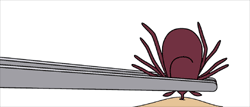
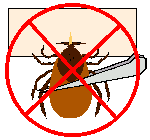
Then it is gently sipped and at the same time rotated around its axis in a convenient direction. Through (1-3) turnover, the tick is removed entirely with the proboscis. If you try to pull the tick off, then the probability of a rupture is high.
Now on sale there are special hooks for removing ticks. Such a hook is similar to a bent two-pronged fork. The mite is inserted between the teeth and is also twisted. There are other tools for removing ticks in humans and animals.
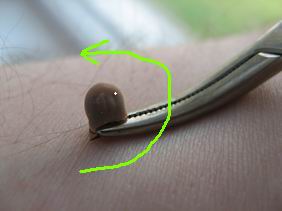
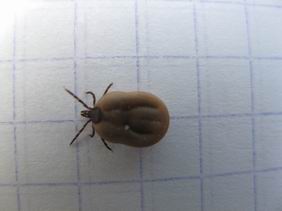
If there are no tools, then you can remove the loop from the coarse string. The loop of the mite is caught as close to the skin as possible and gently, swaying outwards.
Treatment with oil will not make the mite take out the proboscis. The oil will only kill him, clogging the breathing holes. Ticks can be moistened with oil before removing, but you still have to remove it. Oil will cause the mite to regurgitate contents into the wound, which can increase the risk of infection. Therefore, it is better not to use oil.
After removal, the wound is treated with iodine, or another antiseptic for the skin. In the future, the wound is treated with iodine before healing. But I do not need to pour much iodine, because you can burn the skin.
Hand and tool after removing the mite should be thoroughly washed.
If in the wound there was a head with a proboscis, then there is nothing terrible in it. Proboscis in the wound is no worse than a splinter. If the proboscis of the tick extends above the surface of the skin, it can be removed by holding it with tweezers and wringing it out. You can also remove the surgeon from the polyclinic. If you leave the proboscis, a small abscess appears, and after a while the proboscis leaves.
When removing a tick, do not:
Apply caustic liquids - ammonia, gasoline, and others to the place of bite; cauterize the tick with a cigarette;
sharply pull the tick - it breaks;
poking around in the wound with a dirty needle;
apply various compresses to the site of the bite;
press the mite with your fingers.
Remote tick can be destroyed or left for analysis by placing in a jar.
If everything is normal, then the wound heals in a week.
After a tick bite
After the tick is removed, it is necessary:
Take pills, according to the scheme appointed by the doctor (if they were prescribed). If the pathogens of infections were not found during the tick examination, the prophylaxis still continues according to the prescribed scheme;
to monitor the state of health and temperature;
to observe the place of the bite.
If redness occurs at the bite site, consult a doctor. Redness may be a symptom of borreliosis, an allergic reaction (a slight redness around the wound in the first days after a tick bite, is usually a reaction to a bite and passes without consequences.) Or the development of a purulent infection if dirt enters the wound.
If the temperature rises, headache, dizziness, vomiting, pain in the muscles of the trunk and extremities, redness at the site of the bite should be addressed to the infectious disease doctor.
In most cases, the symptoms appear in the second week after the bite. But may appear sooner or later (up to 21 days of tick-borne encephalitis, up to a month of borreliosis).
The appearance of any of these symptoms does not mean that the disease associated with a tick bite has developed, but it is necessary to consult an infectious disease specialist.
Do not overly focus on the bite and listen to the body. There are people who, noticing the bite, immediately find all the symptoms. At the same time, you should not forget that there was a bite, and do not go to the doctor, if you feel worse.
To hand over a blood on kleshchevye infections right after a sting it is not necessary. Analyzes will not show anything. Not earlier than in 10 days it is possible to examine the blood for tick-borne encephalitis and borreliosis using the PCR method. Two weeks later, antibodies to tick-borne encephalitis virus. On antibodies to borrelia a month after the bite.
If 21 days have passed since the bite, tick-borne encephalitis will not develop. In tick borne borreliosis, the incubation period can be up to a month.
Protection against ticks
Ixodid mites carry human and animal diseases: tick-borne encephalitis, borreliosis, erlichiosis and many others.
The best way to prevent these infections is to protect them from tick bites.
The activity of ticks begins at the end of April and ends with the onset of frost. The peak of activity occurs in May-June, but tick bites are possible from April to October. When the soil warms up to (5-7) degrees, the first victims of bites begin to seek help.
Ticks live in forests, parks, in suburban areas. Most of the mites are waiting for the victims on the grass or on the ground. From the trees mites do not jump. The tick clings to the passing victim and searches for a bite for several hours.
Ticks that carry tick-borne encephalitis are in Scandinavia, the countries of eastern and central Europe.
Ticks live not only in forests, but also in parks and garden plots
There may also be mites in the cities: on lawns, in the grass along the roadside.
Ticks sit on the ground, on the grass or on not high bushes.
Ticks can be brought home by animals, on branches, grass
When visiting areas where there may be mites wear closed shoes (boots, boots), and not sandals. Long trousers with puffs on the trousers or tuck the legs into the socks (so that the mite can not crawl under the trousers). Wear jackets with puffs on the sleeves. There are special anti-encephalitic costumes (encephalitis). Such suits are made of dense fabric and are supplied with puffs. They reliably protect against ticks (especially when used correctly, repellents).
Repellents based on DETA discourage ticks, mosquitoes, midges, flies. Apply them to the skin and rinse after visiting the forest. The time of protection is the way of application and contraindications indicated on the package.
For protection against ticks, clothes are treated with preparations containing acaricides (substances killing mites). The acaricide is permethrin or its analogs. After contact with clothing treated with permethrin, the tick dies in a few minutes. Preparations containing permethrin should not be applied to the skin. Now in pharmacies are sold different anti-flesh repellent with permetrin. Such drugs protects against ticks for a week or more.
The tick is looking for a place for a bite for a long time. Therefore, regularly inspect clothes and body. On clothing light tones to see the tick is easier. Unneeded blood ticks are small - a few millimeters long. Ticks belong to arachnids, so they have 8 legs (not 6 as insects).
At home, you need to take off your clothes and inspect the body. The mite can stick anywhere. The shower will not wash off the sucking mites.
Detected mites can not be pressed by the hands, because you can get infected.
Inspect pets after walking. Do not let them lie down on the bed. Mites can be brought home by dogs, cats and any other animals.
If you frequently visit the habitat of mites, it is advisable to get vaccinated against tick-borne encephalitis. The vaccine protects at least 3 years.

